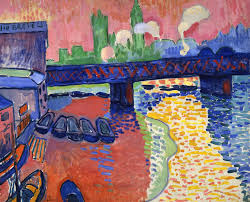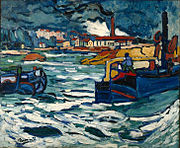André Derain – ‘Charing Cross Bridge’
A style whose name was given to it by a critic and intended as a denigration. A loose group of artists who were devoted to materiality, tonality and strong sensory experience. No, I’m not talking about shoegaze, but about Fauvism. But swap “audio” for “painterly” and “sound” for “colour” in the statement that the Fauves’ works “emphasized painterly qualities and strong colour”, and you start to see the possible links between the two movements. If the Fauvists sought to emancipate pure colour by conveying its energy and expressiveness, celebrating its luminosity and using it to articulate space, then one can say that the shoegaze scene, though purportedly only interested in celebrating itself, sought to do the same for pure sound. But on the face of it, what could connect the ‘wild beasts’ of early 20th-century France, with their bold bright colours and seemingly summery attitude, with a bunch of introverted and soft-spoken Anglophones who have been moping around in their rainy landscapes since the 1980s?
Well, first of all the Fauvist movement was officially born under the possibly saturnine sign of the Salon d’Autumn of 1905. Secondly, perhaps the Fauves didn’t actually have such an outgoing sunny disposition: their “orgy of tones”, after all, prefigured the affective, rebellious and nervy energy of Expressionism. Their paintings were characterized by wild brush work and strident colours, and displayed a high degree of simplification and abstraction – which makes them pretty akin to the dissonant, tremolo-arm favouring, pop-based and abstracted pictures of shoegaze. Both seem to paint a similar dialectic of discordant opaqueness and effusive openness.
The French art-historian and philosopher Georges Didi-Huberman has described the eruption of colour in the monastic paintings of the Early Italian Renaissance painter Fra Angelico as an open and inclusive invitation to lose oneself in a meditation of infinity. With their radiant, abstruse and shimmering intensity, Didi-Huberman says, Fra Angelico’s paintings immerse the viewers in an agitation of coloured matter, an interior act that takes them out of themselves.
The French composer Gérard Grisey famously studied the connection between sound and colour, by dedicating much of his artistic output to exploring the spectrum of tone colour between harmonic overtones and noise. His spectral compositions used computer analysis to examine and illuminate the quality of timbre in music. As Bruce Hodges writes, Grisey’s music “combines rhythmic explorations with the coloristic sense of the Fauves” to offer “sonic revelations.” And when he writes about this music, Hodges could just as well be describing a classic shoegaze song: moments of great ferocity, he says, alternate with moments of eerie quietude, as the timbres “float, hover, barge into your brain, recede, reform themselves, take you hostage.”
Andrew Dickson writes in The Guardian on how American photographer William Eggleston’s colour-saturated photographs created a scandal when first shown at New York’s Museum of Modern Art in 1976: “Colour, as everyone knew, was vulgar, garish, trashy”; definitely not artistic. Interestingly however, as Dickson goes on to explain, Eggleston found inspiration for his intense and raw adventures in colour in the photographs of Henri Cartier-Bresson, a shy Frenchman who worked exclusively in black and white. “For most viewers,” writes Dickson, “Cartier-Bresson’s genius is compositional, residing in his matchless ability to seize crystalline form from the fast-moving muddle of the everyday. William Eggleston, however, was more fascinated by the sophisticated tonal properties of the photographs in The Decisive Moment: their interlocking play of light and shade, the way even the darkest shadows contained reservoirs of meaning.”
In other words, like a proper shoegazer, Eggleston was interested precisely in the places where colour behaves like a blurry, grainy, rainy grey. Residing in a misty Paris, Walter Benjamin once suggested we see fog “as a consolation of the solitary man. It fills the abyss surrounding him.” It is perhaps in the music itself, then, that the shy shoegazer effectively connects to the fierce and extrovert fauve in herself.
Maurice de Vlaminck – ‘Barges on the Seine’

